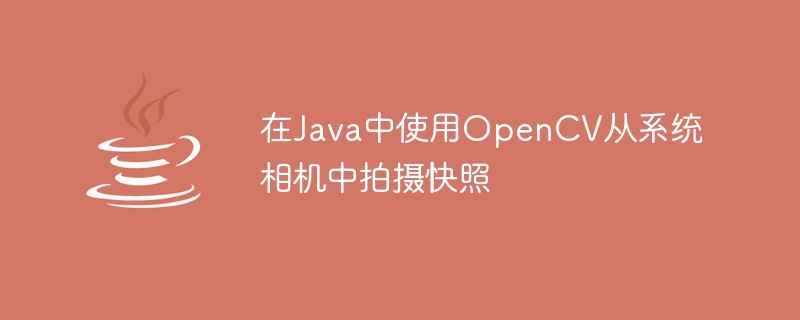Taking snapshot from system camera using OpenCV in Java

Introduction
OpenCV (Open Source Computer Vision Library) is an open source computer vision and machine learning software library. It contains more than 2500 optimization algorithms and is widely used in real-time applications.
Java provides bindings to OpenCV through the JavaCV library, allowing Java developers to leverage the capabilities of OpenCV in their applications. One such application is capturing images from webcams.
prerequisites
To continue, you need the following -
OpenCV is already installed on your system.
JavaCV, a wrapper for OpenCV in Java.
Capturing snapshots using OpenCV
To capture a snapshot, we need to create an instance of the VideoCapture class, which represents the video capture device. We can then use the read method to capture frames from the video source.
Example
Let’s see an example -
import org.opencv.core.Core;
import org.opencv.core.Mat;
import org.opencv.videoio.VideoCapture;
import org.opencv.imgcodecs.Imgcodecs;
public class Main {
static { System.loadLibrary(Core.NATIVE_LIBRARY_NAME); }
public static void main(String[] args) {
// Create a VideoCapture object
VideoCapture camera = new VideoCapture(0);
// Check if camera opened successfully
if(!camera.isOpened()){
System.out.println("Error: Camera not accessible");
return;
}
// Capture a new frame
Mat frame = new Mat();
camera.read(frame);
// Save the frame as an image
Imgcodecs.imwrite("snapshot.png", frame);
// Release the camera
camera.release();
}
}
illustrate
In the above code, we first load the OpenCV library.
Then we create a VideoCapture object for the default camera (index 0). If you have multiple cameras and want to use a different one, you can specify its index when you create the VideoCapture object.
We use the isOpened method to check whether the camera is successfully opened. If the camera is inaccessible, we print an error message and return from the main method.
Next, we use the read method to capture a frame from the camera and store it in the Mat object. Mat (short for Matrix) is the main image structure in OpenCV used to store pixel data.
We use the imwrite method in the Imgcodecs class to save the captured frame as an image and name it "snapshot.png".
Finally, we use the release method to release the camera to release resources.
When you run this program, it will capture a single frame from the webcam and save it as "snapshot.png" in the project directory.
in conclusion
Capturing images from a webcam in Java using OpenCV is a simple process that opens up numerous opportunities for more complex applications such as face recognition, motion detection, etc. Understanding how to use the OpenCV library in Java provides a solid foundation for delving into computer vision and image processing.
The above is the detailed content of Taking snapshot from system camera using OpenCV in Java. For more information, please follow other related articles on the PHP Chinese website!

Hot AI Tools

Undresser.AI Undress
AI-powered app for creating realistic nude photos

AI Clothes Remover
Online AI tool for removing clothes from photos.

Undress AI Tool
Undress images for free

Clothoff.io
AI clothes remover

AI Hentai Generator
Generate AI Hentai for free.

Hot Article

Hot Tools

Notepad++7.3.1
Easy-to-use and free code editor

SublimeText3 Chinese version
Chinese version, very easy to use

Zend Studio 13.0.1
Powerful PHP integrated development environment

Dreamweaver CS6
Visual web development tools

SublimeText3 Mac version
God-level code editing software (SublimeText3)

Hot Topics
 1376
1376
 52
52
 Square Root in Java
Aug 30, 2024 pm 04:26 PM
Square Root in Java
Aug 30, 2024 pm 04:26 PM
Guide to Square Root in Java. Here we discuss how Square Root works in Java with example and its code implementation respectively.
 Perfect Number in Java
Aug 30, 2024 pm 04:28 PM
Perfect Number in Java
Aug 30, 2024 pm 04:28 PM
Guide to Perfect Number in Java. Here we discuss the Definition, How to check Perfect number in Java?, examples with code implementation.
 Random Number Generator in Java
Aug 30, 2024 pm 04:27 PM
Random Number Generator in Java
Aug 30, 2024 pm 04:27 PM
Guide to Random Number Generator in Java. Here we discuss Functions in Java with examples and two different Generators with ther examples.
 Weka in Java
Aug 30, 2024 pm 04:28 PM
Weka in Java
Aug 30, 2024 pm 04:28 PM
Guide to Weka in Java. Here we discuss the Introduction, how to use weka java, the type of platform, and advantages with examples.
 Smith Number in Java
Aug 30, 2024 pm 04:28 PM
Smith Number in Java
Aug 30, 2024 pm 04:28 PM
Guide to Smith Number in Java. Here we discuss the Definition, How to check smith number in Java? example with code implementation.
 Java Spring Interview Questions
Aug 30, 2024 pm 04:29 PM
Java Spring Interview Questions
Aug 30, 2024 pm 04:29 PM
In this article, we have kept the most asked Java Spring Interview Questions with their detailed answers. So that you can crack the interview.
 Break or return from Java 8 stream forEach?
Feb 07, 2025 pm 12:09 PM
Break or return from Java 8 stream forEach?
Feb 07, 2025 pm 12:09 PM
Java 8 introduces the Stream API, providing a powerful and expressive way to process data collections. However, a common question when using Stream is: How to break or return from a forEach operation? Traditional loops allow for early interruption or return, but Stream's forEach method does not directly support this method. This article will explain the reasons and explore alternative methods for implementing premature termination in Stream processing systems. Further reading: Java Stream API improvements Understand Stream forEach The forEach method is a terminal operation that performs one operation on each element in the Stream. Its design intention is
 TimeStamp to Date in Java
Aug 30, 2024 pm 04:28 PM
TimeStamp to Date in Java
Aug 30, 2024 pm 04:28 PM
Guide to TimeStamp to Date in Java. Here we also discuss the introduction and how to convert timestamp to date in java along with examples.




